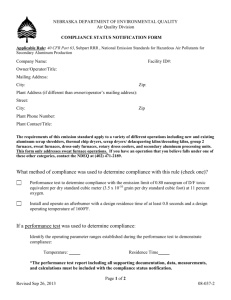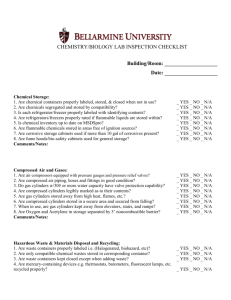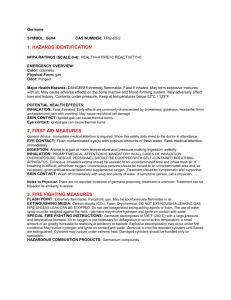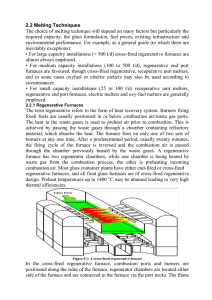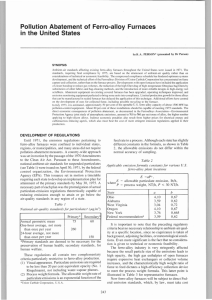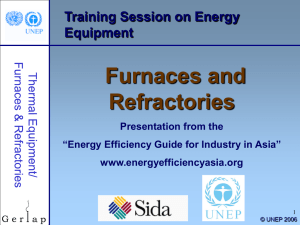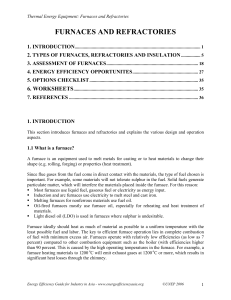Svilen
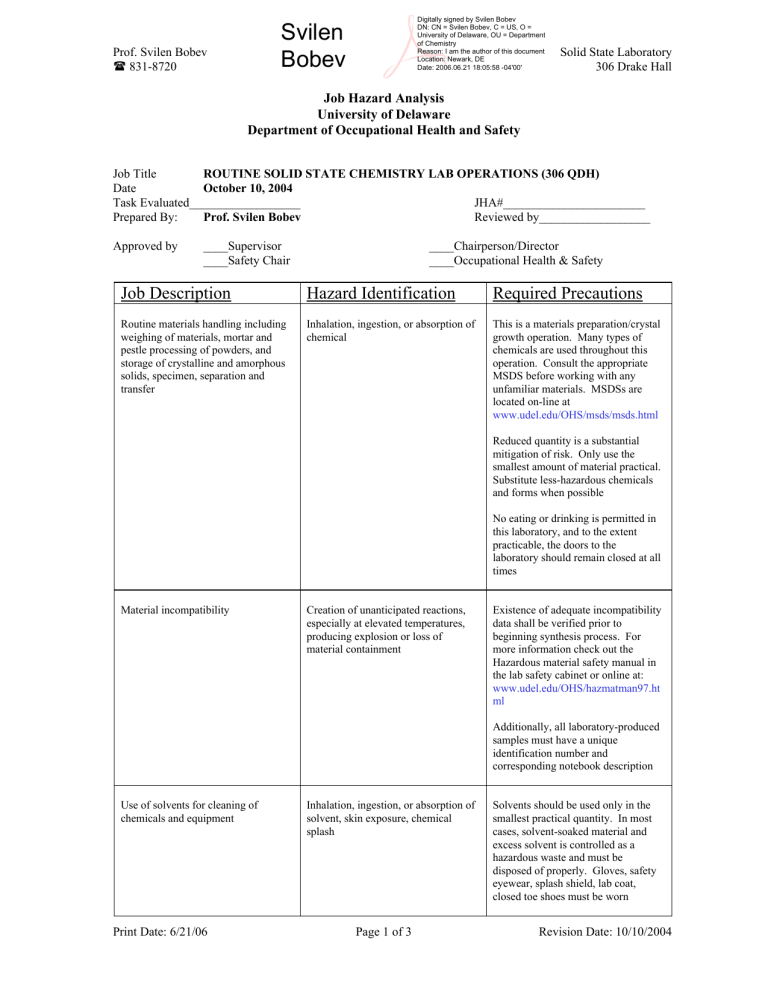
Prof. Svilen Bobev
!
831-8720
Svilen
Bobev
Digitally signed by Svilen Bobev
DN: CN = Svilen Bobev, C = US, O =
University of Delaware, OU = Department of Chemistry
Reason: I am the author of this document
Location: Newark, DE
Date: 2006.06.21 18:05:58 -04'00'
Solid State Laboratory
306 Drake Hall
Job Hazard Analysis
University of Delaware
Department of Occupational Health and Safety
Job Title
Date
ROUTINE SOLID STATE CHEMISTRY LAB OPERATIONS (306 QDH)
October 10, 2004
Task Evaluated__________________
Prepared By: Prof. Svilen Bobev
JHA#_______________________
Reviewed
Approved by ____Supervisor
____Safety Chair
____Chairperson/Director
____Occupational Health & Safety
Job Description
Routine materials handling including weighing of materials, mortar and pestle processing of powders, and storage of crystalline and amorphous solids, specimen, separation and transfer
Hazard Identification
Inhalation, ingestion, or absorption of chemical
Required Precautions
This is a materials preparation/crystal growth operation. Many types of chemicals are used throughout this operation. Consult the appropriate
MSDS before working with any unfamiliar materials. MSDSs are located on-line at www.udel.edu/OHS/msds/msds.html
Reduced quantity is a substantial mitigation of risk. Only use the smallest amount of material practical.
Substitute less-hazardous chemicals and forms when possible
No eating or drinking is permitted in this laboratory, and to the extent practicable, the doors to the laboratory should remain closed at all times
Material incompatibility
Use of solvents for cleaning of chemicals and equipment
Print Date: 6/21/06
Creation of unanticipated reactions, especially at elevated temperatures, producing explosion or loss of material containment
Existence of adequate incompatibility data shall be verified prior to beginning synthesis process. For more information check out the
Hazardous material safety manual in the lab safety cabinet or online at: www.udel.edu/OHS/hazmatman97.ht
ml
Additionally, all laboratory-produced samples must have a unique identification number and corresponding notebook description
Inhalation, ingestion, or absorption of solvent, skin exposure, chemical splash
Solvents should be used only in the smallest practical quantity. In most cases, solvent-soaked material and excess solvent is controlled as a hazardous waste and must be disposed of properly. Gloves, safety eyewear, splash shield, lab coat, closed toe shoes must be worn
Page 1 of 3 Revision Date: 10/10/2004
Prof. Svilen Bobev
!
831-8720
Solid State Laboratory
306 Drake Hall
Acid/base/caustics operations
Operation of ultrasonic bath, hotplate stirrer apparatus
Skin exposure, splash, chemical burn from acids and bases
Because these operations are performed in solutions, particular care should be taken to avoid spills.
Allow chemicals to return to room temperature prior to post-growth handling. Appropriate (i.e., nitrile not latex) gloves as well as eye protection shall be worn when handling chemicals in the liquid state.
When working with corrosive chemicals a face shield and safety glasses with side shields or goggles is required as is a lab coat. Proper waste management training and waste disposal is a MUST
Skin exposure, splash, thermal burns due to inadvertent contact with hot liquids or with surface of reaction vessel
Because the operating temperatures are relatively low (< 200-300ºC), the principal hazard mitigation is awareness. The temperature of the reaction vessel can be read from the temperature controller. Do not access the apparatus without being aware of the temperature
Operations of inert atmosphere glove box - use of compressed gas cylinders in generation of controlled atmosphere for sample processing
Release of stored energy due to cylinder or regulator failure or inadequacy of gas plumbing
Asphyxiation due to release of large volume of gas
Only low-pressure gas flows are employed in this operation.
Compressed gas cylinders must be secured at all times; appropriate regulators shall be used and plumbing shall be inspected prior to use.
Cylinders are capped without regulators when not in use
Introduction and removal of material from furnace
Thermal burns while introducing, removing, and manipulating samples in hot furnaces
All furnaces are commercially available and unmodified. These furnaces are well-shielded and their external surfaces are cool to the touch even when the furnace interior is at maximum temperature; furnace doors must be kept closed when in use to ensure the integrity of this shielding.
No maintenance work shall be performed on furnaces while hot.
Kevlar safety gloves and face shield, as well as lab coat, closed-toe shoes are a must
Inadvertent contact with hot material Thermal burns due to contact with material that has been removed from a furnace while at elevated temperature
The most likely source of thermal burns is contact with material
(including samples, crucibles, and tongs) that have been removed from furnaces to cool. Use commons sense
- any item that is sitting on a firebrick close to a furnace should be assumed to be hot and should not be touched without appropriate caution
Print Date: 6/21/06 Page 2 of 3 Revision Date: 10/10/2004
Prof. Svilen Bobev
!
831-8720
Solid State Laboratory
306 Drake Hall
Centrifugation Thermal burn while sample is being transferred from furnace to centrifuge and during centrifuge operations
The centrifuge shall only be operated when its lid is closed. The same thermal PPE requirements exist as for furnace operation. Operator experience is also a significant mitigator of this hazard; do not attempt this procedure without having received appropriate on the .
Centrifuge operations with samples at temperatures greater than 900°C requires a second observer be present
Utilization of breakable equipment and sharps – glassware, scalpel and razor blades, needles
Possible skin puncture
Use of compressed gasses – argon, oxygen and hydrogen and associated plumbing
Release of stored energy due to cylinder or regulator failure or inadequacy of gas plumbing
Asphyxiation due to release of large volume of gas
Creation of unintended flammable/explosive mixture of hydrogen and oxygen
Only low-pressure gas flows are employed in this operation.
Compressed gas cylinders must be secured at all times; appropriate regulators shall be used and plumbing shall be inspected prior to use.
Adequacy of building ventilation shall be verified before compressed gas operations are initiated.
Hydrogen cylinder is kept 20 feet apart from other gas cylinders.
Special grade tubing for hydrogen and oxygen lines, equipped with flashback arrestors.
Use of laboratory press to compact ceramic or powder samples
Gloves, closed-toe shoes, safety eyewear, tongs to pick up broken glass
Release of stored energy due to press or fixture failure
Because of the low compressibility of the powder samples, the stored energy during such operations is quite low. Maximum force limits of press shall not be exceeded. Alignments of press forms shall be verified visually prior to use
Use of hydrofluoric acid (HF) for materials cleaning
Severe chemical burns, inhalation, ingestion, or absorption of solvent
Details on the procedure, operations, exposure control, PPE are found in a separate document. No work without proper training and signing the user responsibility form
Use of X-ray diffraction equipment for structural studies. Occasional handling of single crystals containing radioactive materials – depleted U,
Th in milligram quantities
Exposure to ionizing X-ray radiation, inhalation, ingestion, or absorption of radioactive materials
Details on the procedure, operations, exposure control, PPE are found in a separate document. X-ray equipment located in separate room - 304 QDH
(X-ray laboratory). No work without proper training and X-ray badge.
Print Date: 6/21/06 Page 3 of 3 Revision Date: 10/10/2004

